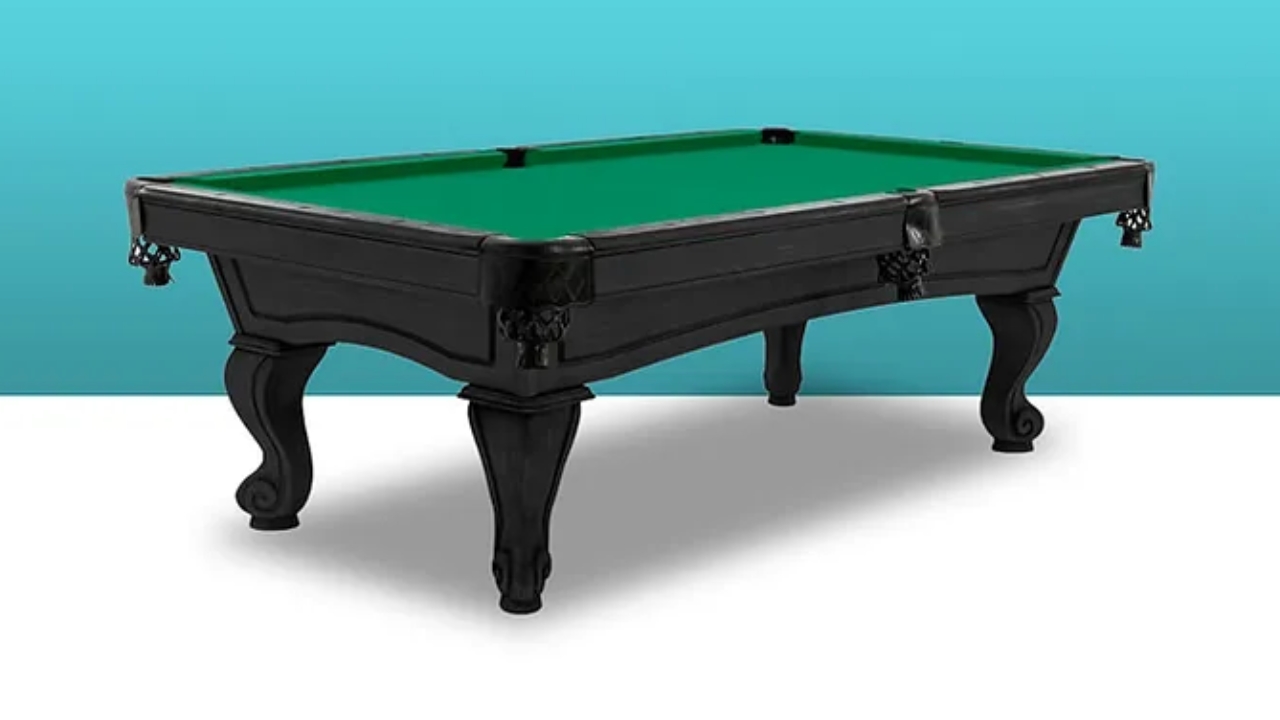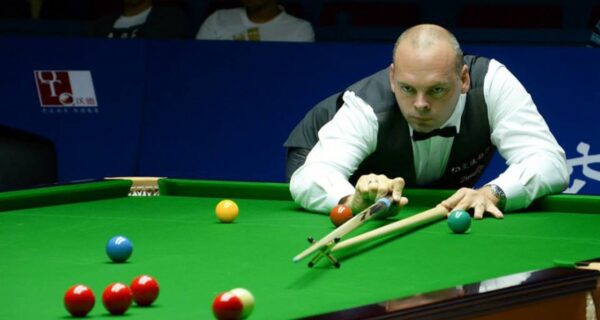A snooker table is more significant than a pool table in size. In snooker, the table’s dimensions are typically 12 feet by 6 feet, while a pool table is commonly 9 feet by 4.5 feet.
This difference in size allows for a more complex and strategic game in snooker, with more balls and narrower pockets, compared to the more straightforward and faster-paced game of pool.
Both games require skill and precision in their respective tables, but snooker provides a larger playing surface that challenges players with longer shots and greater accuracy.
Whether you prefer the larger snooker table or the smaller pool table, both offer exciting opportunities for cue sports fans.
Snooker Table Dimensions
Regarding cue sports, the size of the table plays a crucial role in determining the gameplay. Snooker, known for its meticulous tactics and precision, demands a larger playing area than pool.
In this section, we will delve into the intriguing world of snooker table dimensions, exploring the key factors that determine their size and how they compare to a standard pool table.
Key Factors Determining the Size of a Snooker Table
Snooker tables, renowned for their larger-than-life presence, adhere to specific dimensions set by the World Professional Billiards and Snooker Association (WPBSA).
Several key factors come into play when determining the size of a snooker table:
- The playing surface: The playing surface of a standard snooker table must measure 11 feet 8.5 inches by 5 feet 10 inches (3569 mm x 1778 mm). This precise dimension ensures players have ample room to position balls and execute their shots with precision strategically.
- The cushions: The cushions surrounding the playing surface play a vital role in the game. They need to be precisely placed to ensure consistent ball rebound and accuracy. The standard width for snooker table cushions is 1.376 inches (35 mm).
- The pocket openings: The pocket openings on a snooker table are slightly smaller than those found on a pool table. Measuring approximately 3.5 inches (89 mm) in width, they require players to display exceptional skill in potting a ball.
Comparing the Length and Width of a Standard Snooker Table to a Pool Table
The dimensions of a snooker table emphasize the game’s intricate nature. Compared to a pool table, a standard snooker table is significantly larger.
Here’s a breakdown of the dimensions:
| Snooker Table | Pool Table | |
| Length | 11 feet 8.5 inches (3569 mm) | 7 feet, 8 feet, 9 feet, or 10 feet (varies) |
| Width | 5 feet 10 inches (1778 mm) | 4 feet, 4.5 feet, 6 feet, 7 feet, 8 feet, 9 feet, or 10 feet (varies) |
The larger dimensions of a snooker table create a more intricate playing field, demanding players to master their skills and exhibit pinpoint accuracy.
The elongated dimensions of a snooker table ensure that players have ample space to navigate the game’s intricacies, enabling them to execute strategic shots with precision and finesse.
Pool Table Dimensions
A snooker table is more extensive than a pool table, with dimensions that typically include a longer length and wider width. The extra space allows for the unique gameplay and scoring rules of snooker.
Different Variations of Pool Tables and Their Sizes
Regarding pool tables, different variations are available, each with unique dimensions.
Let’s take a look at some of the popular pool table sizes:
| Table Type | Dimensions |
| Bar Size | 7 feet or 8 feet long |
| Standard Size | 8 feet or 9 feet long |
| Tournament Size | 9 feet long |
These different sizes cater to various preferences and playing styles. The bar-size pool tables, which are 7 or 8 feet long, are commonly found in bars and recreational venues. They are a popular choice for casual players and beginners.
On the other hand, standard-size pool tables measure 8 or 9 feet in length and are suitable for intermediate and advanced players who want a more challenging experience. These tables are often seen in homes and pool halls.
For those looking to take their game to a professional level, tournament-size pool tables are the way to go. Measuring 9 feet in length, these tables are commonly used in competitive events and championships.
Comparing the Dimensions of a Pool Table to a Snooker Table
Now, let’s compare the dimensions of a pool table to that of a snooker table. While both tables are designed for cue sports, their sizes show noticeable differences.
A standard pool table, as mentioned earlier, can measure 8 or 9 feet in length. In terms of width, it typically ranges from 4 to 4.5 feet. The size of the playing surface is essential for determining the ease and accuracy of shots.
On the other hand, a snooker table is considerably larger. A typical snooker table measures a whopping 12 feet long and about 6 feet wide. The larger dimensions give snooker players more space to maneuver their shots and create intricate strategies.
It is worth noting that the larger size of a snooker table necessitates a larger room or playing area. Due to its size, a snooker table is often found in dedicated snooker rooms or professional snooker tournaments.
So, regarding the dimensions, a snooker table is significantly more significant than a pool table. This size difference directly impacts the gameplay, strategy, and overall experience of the two cue sports.
Playing Area Comparison
When it comes to snooker and pool, the size of the playing area is an essential factor that sets these two cue sports apart. Both snooker and pool have their unique characteristics, but the playing area size is one of the critical differences.
In this section, we will delve deeper into the playing area comparison of snooker and pool, examining how the measure affects gameplay and the strategic implications it brings.
Examining the Playing Area Size in Both Snooker and Pool
To understand the differences between the playing areas in snooker and pool,
let’s take a look at the dimensions of both:
| Snooker | Pool | |
| Length | 11 feet 8.5 inches | 9 feet |
| Width | 5 feet 10 inches | 4.5 feet |
From the table above, it is clear that a snooker table is more extensive in length and width than a pool table. The larger dimensions of a snooker table offer a more spacious playing area, providing players with ample room to work with.
On the other hand, a pool table is slightly smaller, creating a more compact playing field.
Analyzing How the Playing Area Affects the Gameplay
The size of the playing area in cue sports like snooker and pool significantly impacts gameplay.
Let’s examine how the dimensions of the playing area influence the way these games are played:
- The larger playing area in snooker: The larger size of a snooker table demands more precision and skill from players. With more space to navigate, players must carefully plan their shots, considering the position of the balls and the available space on the table. The larger playing area in snooker allows for more intricate shot setups and increases the game’s complexity.
- The smaller playing area in the pool: The smaller size of a pool table lends itself to faster-paced gameplay. Shots must be executed precisely in a confined space, making the collection a game of quick reflexes and less room for error. The compact layout of the table requires players to adapt their strategy and approach accordingly, as there is less space to plan and execute complex shots.
The Impact of the Larger Playing Area in Snooker on Strategy and Skill
The larger playing area in snooker not only affects the gameplay but also significantly impacts the strategy and skill required to excel in the game.
Here are some key points to consider:
- Enhanced strategic thinking: The spaciousness of a snooker table allows players to strategize and plan their shots more extensively. The larger playing area will enable players to set up intricate patterns of images, requiring strategic thinking and careful consideration of the cue ball’s position.
- Refined cue ball control: With more room to maneuver, snooker players must have impeccable cue ball control. The increased playing area necessitates precise positional plays and finesse in striking the balls. Players must master the art of controlling the cue ball’s movement over more considerable distances, adding a layer of complexity to their skills.
- Extended potting precision: The longer shots in snooker, made possible by the more significant playing area, demand higher accuracy and precision. Players must hone their long potting skills to consistently pocket balls from a distance, showcasing their game mastery.
In conclusion, the playing area size in snooker and pool significantly impacts the gameplay, strategy, and skills required to excel in these cue sports.
The larger playing area in snooker creates a more strategic and precise game, while the smaller playing area in the pool embraces fast-paced action within confined spaces.
So, whether you prefer the intricacies of snooker or the fast tempo of the collection, the playing area size sets the stage for an immersive cue sports experience.
Room Size Requirements
When setting up a game room at home, one critical consideration is the table’s size. Whether you’re a fan of snooker or pool, both games require a significant amount of space to accommodate the table, cueing area, and enough room for players to move comfortably.
In this section, we will delve into the room size requirements for both snooker and pool tables, discussing the space needed to accommodate each type of table.
Discussing the Space Needed to Accommodate a Snooker Table
A snooker table is more significant than a pool table, making it a centerpiece of any game room. The dimensions of a standard full-size snooker table are typically 12 feet by 6 feet, whereas a pool table is usually 9 feet by 4.5 feet or 7 feet by 3.5 feet.
Therefore, a snooker table requires more room to be set up correctly, allowing players to maneuver comfortably and avoid any potential collisions with surrounding furniture or walls.
Here are the room size requirements for a snooker table:
- The ideal room size for a full-size snooker table is approximately 22 feet by 16.8 feet (678 cm by 512 cm).
- This allows for ample playing space around the table, ensuring players can take their shots without feeling cramped.
- It’s crucial to consider the table’s dimensions and the length of cue sticks, as players need enough space to extend their strokes fully.
- Moreover, additional space is required to accommodate seating areas for spectators or players waiting for turns.
Exploring the Room Size Requirements for a Pool Table
Although a pool table is smaller than a snooker table, it still requires a dedicated space to ensure optimum gameplay. The size of the room needed for a pool table depends on the table’s dimensions and the type of pool game being played.
The most common sizes for pool tables are 9 feet by 4.5 feet and 7 feet by 3.5 feet.
Here are the room size requirements for a pool table:
- The ideal room size for a 9-foot pool table is approximately 18 feet by 13.5 feet (548 cm by 412 cm).
- The recommended room size for a 7-foot pool table is roughly 17 feet by 13.5 feet (518 cm by 412 cm).
- These dimensions provide enough clearance for players to navigate comfortably and take their shots.
- Additionally, it’s essential to consider the height of the cue stick and provide ample overhead clearance to avoid any obstructions.
Understanding the Space Considerations for Each Type of Table
When setting up a game room, it’s crucial to consider the space requirements of both snooker and pool tables to ensure a comfortable playing environment.
While a snooker table is more significant and requires more room, a pool table still demands a dedicated area to accommodate gameplay and players’ movements.
| Table Type | Recommended Room Size (feet) | Recommended Room Size (cm) |
| Snooker | 22 x 16.8 | 678 x 512 |
| 9-Foot Pool | 18 x 13.5 | 548 x 412 |
| 7-Foot Pool | 17 x 13.5 | 518 x 412 |
By understanding the room size requirements and ensuring enough space to accommodate the selected table, players can enjoy the game without feeling cramped or restricted in their movements.
So, when setting up your game room, consider these space considerations to create an optimal gaming experience.
Considerations When Choosing a Table
When it comes to selecting a table for your home or establishment, there are several factors you need to consider. One of the primary considerations is whether you should opt for a snooker table or a pool table.
Both games have their unique features and gameplay styles. However, the question arises – is a snooker table bigger than a pool table?
In this section, we will explore the factors you must consider when deciding between a snooker table and a pool table.
Factors to Consider When Deciding Between a Snooker Table and a Pool Table
Choosing between a snooker table and a pool table requires careful consideration of various factors.
These factors include:
- Available space: The room size or area where you plan to install the table is crucial. Snooker tables are generally larger than pool tables, requiring more space to accommodate their dimensions. Therefore, a pool table might be a more suitable option if you have limited space.
- Game preference: Another factor to consider is your game preference. Snooker and Pool have different gameplay styles and rules. Snooker is a more strategic and complex game, whereas Pool is known for its fast-paced and competitive nature. Understanding the gameplay differences will help you make an informed decision based on your preferences.
- Skill level: Your skill level and experience with the game should also be considered. With their larger size and more challenging gameplay, Snooker tables are often preferred by experienced players. On the other hand, pool tables are suitable for players of all skill levels, including beginners.
- Budget: Budget is an important consideration when choosing a table. Snooker tables are generally more expensive due to their larger size and the materials used. Pool tables, being smaller in size, may be more budget-friendly. It is essential to consider your budget constraints before making a decision.
Discussing the Preference for Larger or Smaller Tables
When it comes to personal preference for table size, opinions vary. Some players prefer the larger size and challenge offered by snooker tables, while others enjoy the convenience and accessibility of smaller pool tables.
Ultimately, your preference depends on playing style, skill level, available space, and personal preferences. Both snooker and pool tables have their unique appeal, so it’s essential to choose the one that aligns with your individual preferences and requirements.
Highlighting the Importance of Understanding the Differences in Gameplay and Table Size
Understanding the differences in gameplay and table size between snooker and pool tables is crucial for making an informed decision.
Snooker tables, typically measuring 12 feet by 6 feet, are larger and pose a more significant challenge due to the smaller pockets and broader playing surface.
Pool tables, measuring 9 feet by 4.5 feet or smaller, have more oversized bags and a compact playing area, allowing for quicker and more accessible gameplay.
By familiarizing yourself with these differences, you can choose a table that suits your playing style, skill level, and available space.
Final Thoughts on Is a Snooker Table Bigger Than a Pool Table
The dimensions of a snooker table and a pool table vary, with the former being larger. The snooker table is usually 12 feet long, while the pool table is typically 9 feet long.
Both games require skill and precision, offering unique experiences for players.
Whether you prefer the challenge of snooker or the popular appeal of the pool, these games are bound to provide hours of entertaining gameplay for enthusiasts.
Choose the table that suits your preferences, and enjoy the game!













